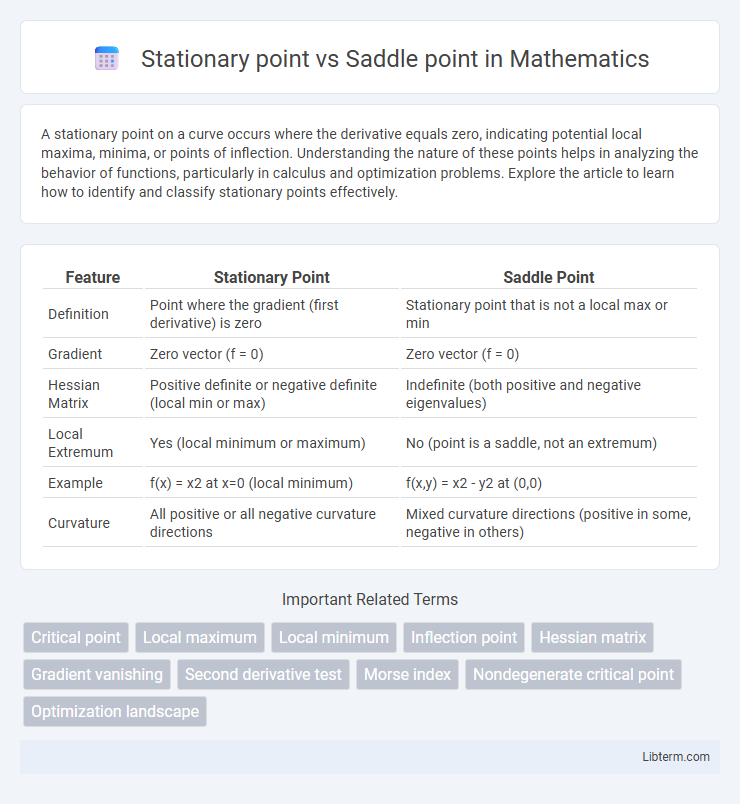A stationary point on a curve occurs where the derivative equals zero, indicating potential local maxima, minima, or points of inflection. Understanding the nature of these points helps in analyzing the behavior of functions, particularly in calculus and optimization problems. Explore the article to learn how to identify and classify stationary points effectively.
Table of Comparison
| Feature | Stationary Point | Saddle Point |
|---|---|---|
| Definition | Point where the gradient (first derivative) is zero | Stationary point that is not a local max or min |
| Gradient | Zero vector (f = 0) | Zero vector (f = 0) |
| Hessian Matrix | Positive definite or negative definite (local min or max) | Indefinite (both positive and negative eigenvalues) |
| Local Extremum | Yes (local minimum or maximum) | No (point is a saddle, not an extremum) |
| Example | f(x) = x2 at x=0 (local minimum) | f(x,y) = x2 - y2 at (0,0) |
| Curvature | All positive or all negative curvature directions | Mixed curvature directions (positive in some, negative in others) |
Introduction to Stationary and Saddle Points
Stationary points occur where the gradient of a function is zero, indicating potential local maxima, minima, or saddle points. Saddle points are specific stationary points where the function curves upward in one direction and downward in another, resulting in neither a local maximum nor minimum. Identifying these points involves analyzing the Hessian matrix to determine the nature of curvature around the stationary point.
Defining Stationary Points: Meaning and Types
Stationary points are locations on a function's graph where the gradient (or first derivative) is zero, indicating potential local maxima, minima, or saddle points. These points are classified into critical types: local maxima where the function value is higher than nearby points, local minima where it is lower, and saddle points where the function changes direction, exhibiting neither a maximum nor a minimum. Understanding these variations helps in analyzing the function's behavior and optimizing complex systems.
Understanding Saddle Points: Characteristics and Examples
Saddle points occur in multivariable calculus where a function's gradient is zero but the point is neither a local maximum nor minimum, displaying characteristics of both increasing and decreasing slopes along different directions. These points can be identified using the Hessian matrix, where an indefinite matrix (having both positive and negative eigenvalues) indicates a saddle point. Classic examples include the function f(x, y) = x2 - y2, which has a saddle point at the origin due to its hyperbolic paraboloid shape.
Mathematical Conditions for Stationary Points
Stationary points occur where the gradient of a function equals zero, satisfying the mathematical condition f(x) = 0. Among these, saddle points are characterized by the Hessian matrix having both positive and negative eigenvalues, indicating neither a local minimum nor maximum. Identifying stationary points involves solving f(x) = 0, while classifying them depends on the definiteness of the Hessian matrix at those points.
Identifying Saddle Points in Functions
Saddle points in multivariable functions occur where the gradient is zero but the Hessian matrix has both positive and negative eigenvalues, indicating a change in concavity along different directions. Identifying saddle points involves calculating the first derivatives to find critical points and analyzing the second derivative test, specifically the Hessian determinant, to distinguish them from local minima or maxima. This method is critical in optimization problems and differential calculus to understand the behavior of complex surfaces.
Geometric Interpretation: Visualizing Stationary vs Saddle Points
A stationary point on a surface is where the gradient vector equals zero, indicating potential local minima, maxima, or saddle points, often visualized as a flat tangent plane touching the curve. A saddle point appears as a stationary point where the surface curves upward in one direction and downward in another, resembling a hyperbolic paraboloid or a mountain pass. Visualizing these points helps distinguish local optima from points of inflection by examining curvature along multiple axes.
Importance in Optimization: Stationary vs Saddle Points
Stationary points are critical in optimization as they indicate where the gradient of a function is zero, representing potential minima, maxima, or saddle points essential for identifying optimal solutions. Saddle points, where a function curves upwards in one direction and downwards in another, can mislead optimization algorithms by causing convergence to non-optimal points. Understanding the distinction between stationary and saddle points is crucial for improving the accuracy and efficiency of optimization techniques in fields such as machine learning and engineering design.
Real-World Applications of Stationary and Saddle Points
Stationary points, where gradients equal zero, are crucial in optimizing engineering designs to achieve maximal efficiency or minimal energy consumption in real-world systems. Saddle points, characterized by having both ascending and descending directions, are essential in machine learning algorithms for identifying critical transition states and improving model training convergence. In economics, stationary and saddle points help analyze equilibrium states and stability in dynamic systems, influencing decision-making and policy development.
Common Mistakes in Differentiating Saddle and Stationary Points
Common mistakes in differentiating saddle points from stationary points arise when the gradient is zero but the Hessian matrix's eigenvalues are misinterpreted. Confusing a stationary point, where all first derivatives vanish, with a saddle point occurs if the mixed partial derivatives and second-order conditions are not thoroughly analyzed. Correct classification requires evaluating the definiteness of the Hessian to distinguish minima, maxima, or saddle points accurately.
Summary: Key Differences Between Stationary and Saddle Points
Stationary points occur where the gradient of a function is zero, indicating potential local maxima, minima, or saddle points. Saddle points are a specific type of stationary point characterized by having a Hessian matrix with both positive and negative eigenvalues, resulting in neither a local maximum nor minimum. Identifying these points is crucial in optimization problems to distinguish between stable solutions and points of inflection.
Stationary point Infographic

 libterm.com
libterm.com